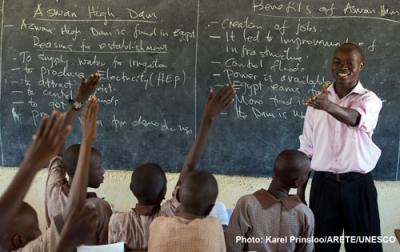
The EFA Development Index (EDI) is a composite index using four of the six EFA goals, selected on the basis of data availability. The goals are:
- Universal primary education (UPE)
- Adult literacy
- Quality of education
- Gender
2015 - Education for All 2000-2015: Achievements and challenges
The EFA Development Index (EDI) and its components, 2012 - ![]() XLS
XLS
EDI components
One indicator is used as a proxy measure for each of the four EFA goals, and each those EDI components is assigned equal weight in the overall index in accordance with the principle of considering each goal as being of equal importance.
The EDI value for a given country is thus the arithmetic mean of the four proxy indicators. Since they are all expressed as percentages, the EDI value can vary from 0 to 100% or, when expressed as a ratio, from 0 to 1. The higher the EDI value, the closer the country is to achieving Education for All as a whole.
Indicators as proxy measures of EDI components
The following proxies have been used in compiling the index:
- Universal primary education: the indicator selected to measure progress towards this goal is the primary adjusted net enrolment ratio (ANER), which measures the percentage of primary-school-age children who are enrolled in either primary or secondary school. Its value varies from 0 to 100%. Therefore, an ANER of 100% means that all eligible children are enrolled in school.
- Adult literacy: Goal 4 proposes achieving ‘a 50% improvement in levels of adult literacy by 2015’. Although existing data on literacy are not entirely satisfactory, the adult literacy rate for those aged 15 and above is used here as a proxy to measure progress.
- Quality of education: The survival rate to Grade 5 was selected for as being the best available proxy for assessing the quality component of EDI, as comparable data are available for a large number of countries.
- Gender: the fourth EDI component is the gender-specific EFA index, the GEI, which is itself a simple average of the three gender parity indexes (GPI) for primary education, secondary education and adult literacy, with each being weighted equally. Therefore it encompasses the two sub-goals of the original EFA goal: gender parity (achieving equal participation of girls and boys in primary and secondary education) and gender equality (ensuring that educational equality exists between boys and girls) proxied by the GPI for adult literacy.
Country coverage and cautionary note
Out of 205 countries, 115 countries had the data required to calculate the standard EDI for 2011. They are ranked according to “high”, “medium” or “low” EDI.
A word of caution: any index that takes a complex and multifaceted reality and compresses it into something much simpler will always do injustice to the original. For this reason, it is important to realize that indexes may be useful for particular purposes, but they also have limitations. Data and indicators should be viewed within the broader picture of a dynamic and specific country context that is itself evolving within a larger sub-regional or regional environment. Therefore data must be interpreted with care as good data and good measuring tools are often lacking where needed most. We therefore urge our readers to takes these strengths and limitations into account.
